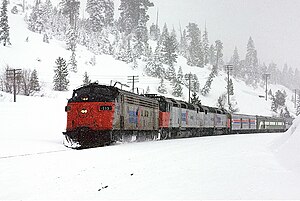San Francisco Zephyr
 An EMD FP7 and two EMD SDP40Fs pull the eastward San Francisco Zephyr through the Sierra in 1975 | |||||
| Overview | |||||
|---|---|---|---|---|---|
| Service type | Inter-city rail | ||||
| Status | Discontinued | ||||
| Locale | Western United States | ||||
| Predecessor | City of San Francisco/Denver Zephyr | ||||
| First service | June 11, 1972 | ||||
| Last service | July 15, 1983 | ||||
| Successor | California Zephyr | ||||
| Former operator(s) | Amtrak | ||||
| Route | |||||
| Termini | Chicago, Illinois Oakland, California | ||||
| Stops | 36 | ||||
| Distance travelled | 2,390 miles (3,850 km) | ||||
| Train number(s) | 5, 6 | ||||
| Technical | |||||
| Track gauge | 4 ft 8+1⁄2 in (1,435 mm) | ||||
| |||||
The San Francisco Zephyr was the name adopted in June 1972 for the Amtrak passenger train between Chicago, Illinois, and the San Francisco Bay Area in California. Previously, those wanting to take a train between Chicago and Oakland, would have to take the Denver Zephyr which ran daily between Chicago and Denver, and the City of San Francisco, which ran three times a week, between Denver and Oakland.
Because of the refusal of the Denver and Rio Grande Western Railroad to join Amtrak in 1971, and their decision to maintain their own train, the Rio Grande Zephyr, between Denver and Salt Lake City, once reaching Denver, the San Francisco Zephyr was required to head north, where it joined the Union Pacific's Overland Route, at a junction just west of Cheyenne, Wyoming, to continue through southern Wyoming, via Laramie, to Ogden, Utah. For passengers wanting to use the Rio Grande's service and continue on Amtrak, the timing of the trains was coordinated to facilitate a connection in Ogden (but not Denver) with the D&RGW's Rio Grande Zephyr.[1] The San Francisco Zephyr traveled over rails operated by three different railroads: the Burlington Northern between Chicago and Denver, the Union Pacific between Denver and Ogden, and the Southern Pacific between Ogden and Oakland.
In July 1980, the San Francisco Zephyr was outfitted with Amtrak's new bi-level Superliner passenger cars, one of the last western trains to receive them. One of the results of this was that through service was introduced between Chicago and Seattle, as the Pioneer, and Los Angeles as the Desert Wind, with both the Pioneer and Desert Wind traveling with the Zephyr between Chicago and Ogden.
In 1983 the D&RGW chose to join Amtrak, citing increasing losses in passenger operations. Amtrak re-routed the San Francisco Zephyr over the D&RGW's line between Denver and Salt Lake City, Utah, which was its original preference in 1971. The change was scheduled for April 25, but a mudslide at Thistle, Utah, closed the D&RGW's main line and delayed the change until July 16. With the change of route Amtrak renamed the train California Zephyr.[2][3]
In media
In an episode of the British program Great Railway Journeys, aired in 1980, presenter Ludovic Kennedy travels from New York to Los Angeles by rail, riding on the San Francisco Zephyr between Chicago and Oakland.
References
- ^ Amtrak (June 11, 1972). "Nationwide schedules of intercity passenger service". Retrieved September 12, 2010.
- ^ "Scenic route to be taken by Amtrak". Eugene Register-Guard. March 17, 1983. Retrieved September 12, 2010.
{{cite news}}: Italic or bold markup not allowed in:|publisher=(help) - ^ "Last passenger trains rolling across Wyoming". Spokesman-Review. July 13, 1983. Retrieved September 12, 2010.
{{cite news}}: Italic or bold markup not allowed in:|publisher=(help)
External links
![]() Media related to San Francisco Zephyr at Wikimedia Commons
Media related to San Francisco Zephyr at Wikimedia Commons
- Former Amtrak routes
- Passenger rail transportation in Illinois
- Passenger rail transportation in Iowa
- Passenger rail transportation in Nebraska
- Passenger rail transportation in Colorado
- Passenger rail transportation in Wyoming
- Passenger rail transportation in Utah
- Passenger rail transportation in California
- Railway services introduced in 1972
- Railway services discontinued in 1983
